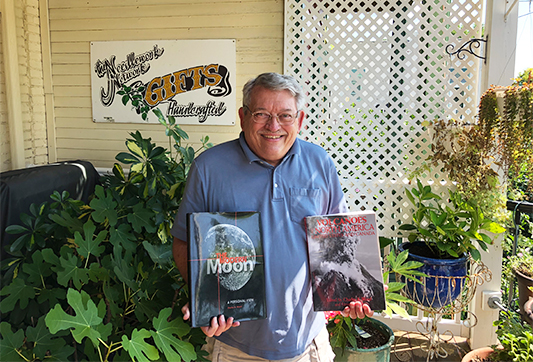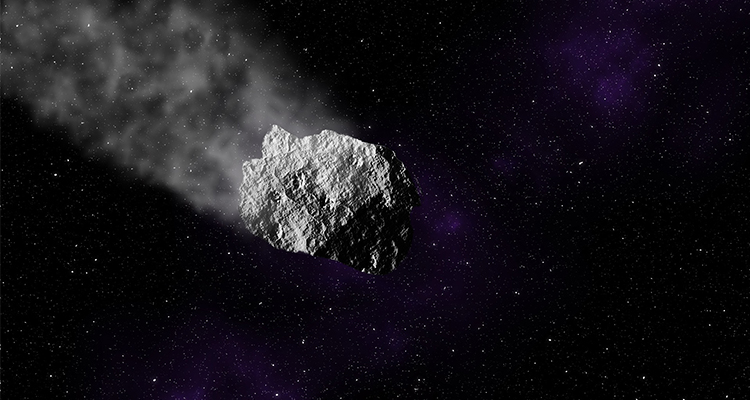While many industries award top leaders in their fields with lifetime achievement awards, these awards are almost always terrestrial. But for Wheeling scientist and author Dr. Chuck Wood, the legacy of his career can be seen in space (albeit with a high-powered camera and well-trained eye).
On Aug. 9, the International Astronomical Union named asteroid 363115 “Chuckwood” in recognition of Wood’s career in both research and science education.
The formal citation reads: “Charles (Chuck) Wood made fundamental insights into the role of cratering and volcanism in shaping planetary surfaces. He tirelessly promoted science education through numerous books, popular articles and the Internet. His development of education programs introduced many students to science.”
“The citation was written in past tense, as if I’m dead,” said Wood. “I can assure you I’m not.”

Still alive — and still working in science education — Wood is the executive director of the Center for Educational Technologies at Wheeling Jesuit University. In this role, he works to provide area students with hands-on experiences that introduce them to science and astronomy, areas he has been fascinated with since his own days as a student.
“I saw an eclipse of the moon when I was in the fifth grade, and that’s the earliest I can remember being interested in astronomy,” Wood said. “I grew up during the space race between the U.S. and Russia. I just happened to be at the right place at the right time and at the right age.”
His interest in astronomy stayed with him throughout high school and college, where he earned his bachelor’s degree in astronomy at the University of Arizona. After finishing college, Wood served in the Peace Corps in Kenya before returning to Arizona to earn his master’s degree in geophysics, eventually finishing his education at Brown University with a second master’s degree in geology and a doctorate in planetary science.
In 1980, Wood began working as a space scientist for NASA at Johnson Space Center in Houston, Texas. While at NASA, Wood and a colleague found that some of the meteorites that land on earth’s surface originate from the planet Mars, a revolutionary discovery at the time.
“I gave a talk in 1981 about that, and when the talk was introduced and I was walking up to the stage, people were laughing and ridiculing saying it’s impossible,” Wood said. “The next year at the same conference there were 26 talks on meteorites from Mars.”
Prior to their discovery, scientists believed that all meteorites break off of asteroids, large chunks of extraterrestrial rock like the Chuckwood. While experts now concur that some meteorites come from other sources, most still originate from asteroids. However, there is little cause to fear Chuckwood ever falling toward Earth.
“Asteroids are rocks floating in space between Mars and Jupiter,” said Wood. “My asteroid is in a place in the asteroid belt where it is very difficult to get a meteorite to come down to Earth.”
In addition to his own research at NASA, Wood became the head of the Space Shuttle Earth Observations Office, training astronauts on how to take pictures of the Earth.
“I’ve been lucky,” said Wood. “I’ve met a number of the astronauts who have been to the moon. Working with astronauts was neat, a different type of real heroes we mostly just see on TV.”
Despite the excitement of working at NASA, Wood missed working with students as he had as a graduate student.
“When I was a graduate student, I started going around giving talks to school kids about the moon, about space and astronomy,” Wood said. “It’s great to have an expert come and talk to your class. As a kid, I used to write letters to famous scientists, and it’s surprising how many would write back. That sort of intergenerational contact is something I’ve tried to continue as I’ve gotten older.”
One method Wood has used to spread knowledge about science and kindle young people’s interest in the field is the Internet. In the 1990s, he created a website with the help of a NASA grant on volcanoes that received over 4 million views in one year. Early on in the dotcom age, millions of views was a very significant milestone.
“If you’re a scientist and you write a scientific paper, I read once that your paper is read by one and a half readers,” said Wood. “If you do a paper that’s important, well maybe you’ll get hundreds of readers. But you can do a website and reach millions of people versus a handful of scientists.”
While still the administrator of numerous websites on astronomical topics, Wood is also a prolific writer as well. Since his first published research paper as an undergraduate, he has written over 200 articles and numerous books on the moon, volcanoes and impact craters.
Though well respected by his peers for his contributions to research and science, Wood ’s devotion to science education has become the focus of his work. At Wheeling Jesuit, he continues to find new ways to keep the next generation interested in science and space.
“I’ve had so much luck of being involved in scientific activities all my life,” Wood said. “What I try to do is tell the stories of those things in different ways.”
• Nick Musgrave is a self-described history geek living in Wheeling, W.Va. He is a graduate of Hastings College in Hastings, Neb., where he earned his bachelor’s degrees in history and political science. When not writing for Weelunk or uncovering cool stories about the past, he can often be found reading in his hammock or trying to brew the perfect cup of coffee.


